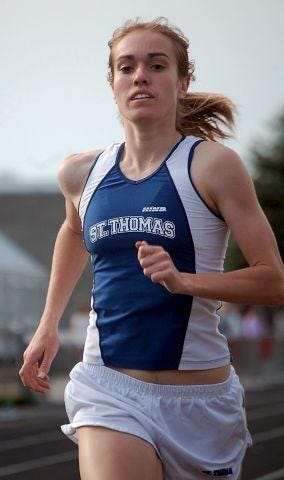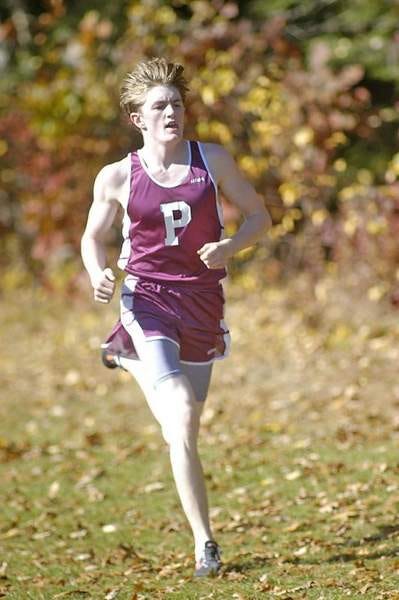The New Hampshire seacoast is a hotbed of milers-turned-10K-studs
Alternatively, an excuse to review some great track racing, or whatever it's best called lately.
Rachel Schneider and Eric Jenkins are American distance runners in the primes of their careers. Schneider turned 29 in July, Jenkins in November. If you watched or heard about The Sound Running Track Meet in Southern California last weekend, you know that they won their respective events, the 10,000 meters, against the best North American athletes healthy and willing — or able — to compete (results). The entire purpose of this meet-like gathering was to allow athletes to reach the U.S. Olympic Trials or Olympic Games qualifying standards, which are 28:00 and 27:28 for men and 32:25 and 31:25 for women. Why this meet took place in December is fairly easy to piece together for students of recent public-health history.
Photos courtesy of Justin Britton for Letsrun.com
Perhaps the most interesting twist in a two-night meet that offered a lot of unusual positives was the runner who had placed fourth in the 5,000 meters on Friday in 13:18.57, previously underheralded Sam Atkin, not only assuming 10,000-meter pace-setting duties the next night, but staying in the race the whole way and landing an OG qualifier with a 27:26.58, also good for fourth. Ignoring this and similar nuggets, I have an excuse to focus squarely on the fact that Schneider (31:09.79 in her track debut at the distance) and Jenkins (27:22.06) have a lot more in common than getting Olympic qualifying marks a week ago. They went to high schools less than 9 miles apart on the New Hampshire seacoast (what there is of it — about 20 miles) at the same time, Schneider graduating in 2009 and heading south to Georgetown and Jenkins finishing a year later and packing his bags for Northeastern, albeit as an unplanned way-station en route to the University of Oregon. And each spent time chiefly as a miler — not exactly wallowing there, and one for far longer than the other — before moving up to a distance that seems to be the best for both.
Schneider is actually from Maine, but attended St. Thomas Aquinas Academy in Dover, N.H. just over the border from her hometown, and a few miles from where my parents have lived since 2004. I lived in Dover myself for about a year and a half before coming to Colorado in 2010, and have been back for a few stretches since. There is nothing about the town or the area that should breed distance talent, though the few jewels other than the two anchoring this post have been of the very glittery type, as I’ll get to.
Photo courtesy of Right-Click/Save Image As…
Schneider did not compete in cross-country as a freshman, but ran indoors that winter and by the end of outdoors had run no worse than 2:20 for the 800m and 5:08 for the 1,600m. (It should be evident that I’m getting this stuff from the Web, not mouths or e-mails, and that my research is likely to have gaps, which I predict will be of little consequence.) In her final three prep years, she was 3rd, 7th and 2nd at her D-2 state cross-country meets and 3rd, 21nd and 5th at the corresponding Meets of Champions (Meet of Championses?), but her real strength was on the track, where she was a double 800m-1,600m winner her senior year at the New Englands with marks of 2:11.89 and 4:51.00.
In other words, Schneider was a consistent and very good performer from the start, with a lot of lightning and the end. Other than the last bit, Jenkins’ high-school career, such as it was, had nothing in common with his older neighbor’s, offering few hints of excellence until it was practically over.
Jenkins was a unremarkable runner for a mediocre-to-dismal team, Portsmouth High, until his final cross-country season. In light of seemingly reliable rumors bouncing around the New Hampshire Cross-Country Coaches Sewing Circle (not a real organization, though I am an honorary member) that Jenkins’ summer training topped out at a yeoman three miles at a shot, three times a week, this is not surprising. Although he ran four years of cross-country, he didn’t run track, indoors or outdoors, until his senior year. As a freshman, he was 34th in the Division 2 State Championships at Derryfield Park in 18:37. As s sophomore, his 17:06 at States was good enough for 15th (one place ahead of fellow 10th-grader Aaron Watanabe of Hanover, a detail that soon assumes significance) and a trip to the statewide Meet of Champions at much faster Mine Falls Park, where his 16:45 earned him 44th. As a junior, he was 13th at States in 16:40, over 200 meters behind Watanabe’s winning 15:51, and 13 seconds ahead of Hanover’s seventh runner; for whatever reason, he skipped the Meet of Champions the next week.
In the fall of 2009, Jenkins, last seen in a team uniform almost a year earlier, didn’t run the Manchester Invitational at the end of September, despite Portsmouth being there. Watanabe did, and facing competition from throughout the Northeast, hammered out a 15:38 for third place. At the time, this was, I believe, the third-fastest time by a New Hampshire runner on the Derryfield Park course, with the only two superior marks coming in 1994, by John Mortimer (15:24) and Matt Downin (15:30). Considering that Downin and Mortimer went 1-2 at the Foot Locker National Finals that fall, 15:38 can be regarded as unusually fast at Derryfield.
Photo courtesy of Ken Stejbach for Seacoast Online
Although Jenkins broke the venerable Cory Thorne’s Portsmouth home-course record that autumn at the Seacoast Championships, no one pays much attention to that shit, and I would guess that few were ready for him to run 15:32 at D-2 States and beat Watanabe by seven seconds. Not only was this a jolt to the scene in itself, with two D-2 kids knocking out close to 5:00 miles at Derryfield, but the next week, on a fast course, the two would face not just each other but three runners from D-1 Bishop Guertin who had all dipped into the 15’s themselves there, backed by fourth and fifth runners good enough to make the’09 BG team among the best New Hampshire had ever seen.
At Mine Falls Park, Jenkins again outran Watanabe — who would go on the next spring to become the first sub-9:00 3,200-meter runner in state history — by seven seconds in a course-record time of 15:16.2. (Last month, sophomore Aidan Cox of Coe-Brown ran the first sub-15:00 ever at Mine Falls with a 14:58.8, a week after a boggling 15:15 at Derryfield. The kid is 15 and a half years old.) Jenkins then finished 19th at the “New England” Championships (scare quotes indicative of the absence of Massachusetts, which contributes significantly to the six-state region’s population as well as its hellish accents).
That winter, with evidence mounting that he might be good at certain events in the related sport of track, Jenkins decided to give indoors a whirl. He wound up with D-2 state titles in the 1,500m and 3,000m (beating Watanabe) and best marks of 4:04.56 and 8:53.10. He was fourth at the indoor New Englands in the two-mile in 9:24.66 (the track New Englands actually include Massachusetts, so no scare-quotes here). Outdoors, he ran one event at the D-2 State Championships, the 1,600m, winning it in 4:20.55, and ran the same event the next weekend at the Meet of Champions, winning that one as well in 4:15.20. As he didn’t run the New Englands the following weekend, those two four-lap races are, according to Google (Beck, 2020) basically the entirety of his pre-collegiate track races of note.
You’ll get no review here of either runner’s college or pro careers in depth, partly because I’m lazy but also because a lot of readers of this blog (he fancies) are from New Hampshire and are more interested in everything I just wrote than anything I could add on this front about the years between 2010 and now. Of some curiosity is that Jenkins’ freshman-year roommate at Northeastern, a Massachusetts state long-jump champion, is the son of the woman who my mom’s closest friend throughout most of my childhood. (That friend is considerably younger than my mom, in case any of that sounds weird as well as gratuitous.) But in brief, each has made one World Championship team in the 5,000m, Jenkins in 2017 and Schneider last year. Jenkins has run 13:07 for the distance, but that was five years ago, so his 26-second 10,000m PR last week being at that level or better is noteworthy. Schneider seems to keep improving no matter what she does, and if you watched the race last Saturday and paid attention to how restrained she looked even with three laps left, the outcome seemed assured far in advance. In addition, Laz Lake was reportedly seen capering in the otherwise-empty stands, beard on fire like an Appalachian pirate and demanding that no one anywhere talk about anything, anywhere, related in any way to human relations. L’Chaim.
Anyway, I’m trying to get out of the natural but prickly habit of starting final paragraphs with “anyway,” so instead I’ll provide the names of few others who have trod the same general patch of land in a successful way. I’ll also advise you never to go to Hampton Beach unless you take, or sell, a lot of DMT or are into watching old Quebec dudes in Speedos hit on girls from Phillips Exeter Academy. Rye Beach is okay, but while we’re on the subject, no beach in New England is worth a shit. Long Island Sound is too filthy for Connecticut to stand a chance, the water is far too cold everywhere else, and there has never been anything good about Cape Cod other than the curious accents, which I attribute to the overconsumption of witch hazel. I may be thinking too deeply of the Kennedys, or of Kitty Dukakis. Regardless, Cathy Schiro O’Brien, who made two Olympic teams in the marathon, is a 1985 graduate of Dover High School and a national Foot Locker champion. Lynn Jennings spent most of her nonpareil career living and training not far away in Newmarket. Andrew Huebner, who is just a few seconds off the fastest marathon by New Hampshire resident with a 2:17:06 from Grandma’s in 2014, is from Portsmouth, though he attended Governor Dummer (tell me about it) Academy down the road in Massachusetts. And Guy Stearns, a 28:31 10K guy in the 1980s, was based in Portsmouth in his salad days, and is too old to receive a link to anything. But primarily because the winters suck — cold and humid, and nothing especially captivating to look at or watch for except for the next snowplow or foot-tall frost-heave — it may be a while before even one runner as good as either Schneider or Jenkins wobbles out of Rockingham or Strafford County, much less two more or less in concert.




